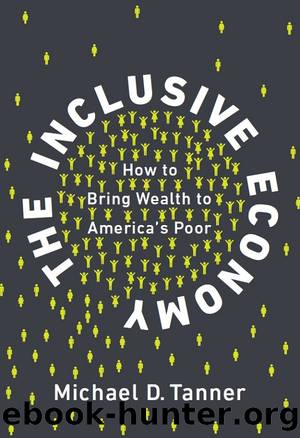The Inclusive Economy by Michael D. Tanner

Author:Michael D. Tanner [Tanner, Michael D.]
Language: eng
Format: epub
Tags: Social Science, Poverty & Homelessness, Political Science, Public Policy, Social Services & Welfare, Law, Criminal Law, General
ISBN: 9781948647021
Google: cT58DwAAQBAJ
Publisher: Cato Institute
Published: 2018-12-04T05:13:11+00:00
CHAPTER SEVEN: REDUCING THE COST OF HOUSING THROUGH DEREGULATION
Housing is absolutely essential to human flourishing. Without shelter, it all falls apart.
âMatthew Desmond1
It has long been a rule of thumb that families should spend no more than 30 percent of their income on housing. The reality, however, is that most people living in poverty spend even more. Indeed, in 2014 Americans in the lowest third of incomes spent on average 40 percent of their income on housingâand renters in that third spent nearly 50 percent of their income on housing.2
Contrary to popular belief, homeownership rates are actually quite high among low-income American families. Roughly 40 percent of poor households own their home.3 In many ways, the prevalence of homeownership among families who are otherwise poor illustrates the difficulties in defining poverty in America.4
However, simply looking at the levels of homeownership among the poor implies a level of affluence that is misleading. Many have little equity in their homes, and often the homes would be difficult to turn into income. Others purchased homes before they were poor, yet subsequently saw their incomes plummet. These individuals can be described as âhouse poor,â with mortgage and upkeep consuming substantial portions of their income, leaving them unable to meet other financial needs. Moreover, the homes may be in disrepair, with nearly 5 percent of people who are poor reporting a leaking roof and almost 10 percent reporting pests in the house in one survey.5 Furthermore, one study estimated that more than half of low-income housing suffered from three or more of âexposure-relatedâ problems such as mold, combustion by-products, second-hand smoke, chemicals, pests, or inadequate ventilation.6
Nor is homeownership evenly distributed across all categories of the poor. The elderly poor are more likely to own their homes than young families and to have a low or no mortgage if they do own. Whites are more likely to own than African Americans, and their homes are typically more valuable as well.7 A Brookings Institution study concluded that lower-income white neighborhoods had more home value compared to income than low-income minority neighborhoods.8
Despite the nationâs high rate of homeownership, it is still true that the majority of low-income households rent, and here the problems are easier to see.9 Rents have risen far faster than incomes since the 1990s. Among low-income families who rent their homes, more than 50 percent spend more than half of their income on rent and other housing costs such as utilities, with nearly a quarter of such tenants spending more than 70 percent.10 Roughly 1 in 10 poor Americans report that they cannot pay their rent and an equal number are worried that they might not be able to in the future.11 High rents are an even bigger problem in some states and cities. In San Francisco, a one-bedroom apartment averages an astounding $3,460.12 In New York, the average rent is over $3,000, and itâs more than $2,000 in Boston and Washington, D.C. In Americaâs opportunity-rich cities, most rental units are out of reach for the poorest families.
Download
This site does not store any files on its server. We only index and link to content provided by other sites. Please contact the content providers to delete copyright contents if any and email us, we'll remove relevant links or contents immediately.
International Integration of the Brazilian Economy by Elias C. Grivoyannis(91641)
The Radium Girls by Kate Moore(11930)
Turbulence by E. J. Noyes(7942)
Nudge - Improving Decisions about Health, Wealth, and Happiness by Thaler Sunstein(7622)
The Black Swan by Nassim Nicholas Taleb(7016)
Rich Dad Poor Dad by Robert T. Kiyosaki(6413)
Pioneering Portfolio Management by David F. Swensen(6229)
Man-made Catastrophes and Risk Information Concealment by Dmitry Chernov & Didier Sornette(5925)
Zero to One by Peter Thiel(5691)
Secrecy World by Jake Bernstein(4652)
Millionaire: The Philanderer, Gambler, and Duelist Who Invented Modern Finance by Janet Gleeson(4385)
The Age of Surveillance Capitalism by Shoshana Zuboff(4214)
Skin in the Game by Nassim Nicholas Taleb(4165)
Bullshit Jobs by David Graeber(4101)
The Money Culture by Michael Lewis(4082)
Skin in the Game: Hidden Asymmetries in Daily Life by Nassim Nicholas Taleb(3935)
The Dhandho Investor by Mohnish Pabrai(3705)
The Wisdom of Finance by Mihir Desai(3658)
Blockchain Basics by Daniel Drescher(3511)
